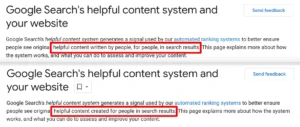
Are you being served? I make sense of Google’s significant March spam update so you don’t have to

At Embryo, we’re on top of all industry updates big or small, and it has now been a week since Google announced the March 2024 Core Update, as well as the Spam Update. In an unusual step for Google, they provided a detailed update about what it entails, specifically what it was they were rolling out to combat.
The core update is being classed as a ‘complex update’ and could take up to a month to roll out, and by Google’s admission, there are likely to be more fluctuations in rankings than usual.
Ultimately the core update is reviewing helpful content and is likely to be off the back of the many updates we saw at the end of last year which saw websites that undertook user-focused content experience an uplift in performance.
This is nothing new and sites should continue to review their content and look to offer users a how, what, why, and when solution for user queries.
The biggest part of this combined update is the Spam Update.
- This covers 3 areas:
- Expired Domain Abuse
- Scaled Content Abuse
- Site Reputation Abuse
Examining the Spam Update
Three big areas directly address any negative practices that websites may be undertaking to manipulate and will likely be hand in hand with the main Core Update.
1. Expired Domain Abuse
This is an old strategy/tactic, where a business would buy a domain with a decent backlink profile, then look to redirect this to their main site in the hope that the wave of authority will help improve the organic visibility.
Google has denied that this was a tactic that worked in manipulating the rankings but now it looks like they have enough data and learnings to address this.
Nine times out of ten the authority passed to the main domain through this tactic is unlikely to be relevant and we have seen over the past couple of years that the best authority is a relevant authority, which can be achieved through Content Marketing and Digital PR.
Google has provided more information about Expired Domain Abuse.
2. Scaled Content Abuse
“When many pages are generated for the primary purpose of manipulating search rankings”, is a sentiment from Google that I saw coming.
The explosion of AI content in the search rankings took me back to when building link after link after link was a tactic commonly used pre-2012 until Google’s Penguin update saw to it that sites could manipulate search rankings.
The introduction of more AI tools has allowed sites and businesses to create pages and pages of content at will. This has caused Google to react. And react hard. Similar to how the Penguin update was rolled out.
This isn’t to say that Google doesn’t like AI content, remember back in September 2023? In an algorithmic update, Google made a small but significant change to its definition of what ‘Helpful content’ is, removing the ‘by people’ hinting at a softening toward the appropriate use of AI content.

(image source: Search Engine Land)
Many believe that this was a gentle approval of the use of AI to create helpful user-focused content while cautioning against using it to generate significant amounts to try and manipulate the rankings.
There has been talk across social media and forums that traffic to sites has significantly reduced due to this update (still, remember that the update is still currently being rolled out) and that it is still unknown if those sites utilised AI, or not, to create their pages.
This would make me believe that this isn’t about whether the content is created by humans or AI, but the quality of what’s being produced, and whether it serves the user’s needs.
Remember, Google’s quality rater guidelines around E-E-A-T should always be adhered to when creating content.
This includes creating author bios which can show that an authority in an industry has written authoritative content. This will also include full name, headshot and link to other pieces of work they may have written (as well as their LinkedIn profile).

Despite numerous updates about E-E-A-T, sites still ignore the main purpose of this update despite it being Google’s default suggestion on how to create content that ranks for a while now.
For more information on Scaled Content Abuse visit Google.
3. Site Reputation Abuse
What counts as site reputation abuse? To answer that, let’s go straight to the main source.
Here’s what Google says: “Site reputation abuse is when third-party pages are published with little or no first-party oversight or involvement, where the purpose is to manipulate search rankings by taking advantage of the first-party site’s ranking signals.
“Such third-party pages include sponsored, advertising, partner, or other third-party pages that are typically independent of a host site’s main purpose or produced without close oversight or involvement of the host site, and provide little to no value to users.”
I would see this more in line with Google’s role out of the Penguin updates. This clamped down on businesses finding websites that have good visibility and that allow guest articles, then creating a piece of content to drive authority (link) back to your main site.
The use of AI, as well as finding sites driving non-relevant authority to sites, has allowed brands to rank well, with Google looking to give sites warnings about this practice. Incidentally, they’ve let us know that they will start clamping down on this in their May 2024 update.
It may be worrying for many sites that Google has given an unusual warning like this and I again refer back to the Penguin update reference, this could affect sites.
I would recommend any site undertake a full backlink profile analysis before the end of March and either remove or disavow any spammy links and look to replace authority through digital PR and content marketing.
This is the most effective way to generate authority back to your site, increase your brand standing and become an expert.
Here is more information on Site Reputation Abuse and its effects.
Conclusion: Should I Be Worried?
Sites that have been carefully following Google’s guidelines and updates for the past couple of years shouldn’t have anything to worry about.
But, those who have tried to cut corners and have tried to jump the SEO processes to get into key search positions could be in real danger.
For the first time in a long time, Google’s pre-update message included the words “Spam Manual Action”, these are words that send shivers down SEO’s spines, especially those involved in SEO around the Penguin era.
Receiving these messages doesn’t signify the end of a business’s site but it does mean weeks or even months of potentially low traffic, whilst the brand or the SEO marketing agency which it works with works through a reconsideration request and builds the right signals to Google.
But this is big, really big.
Google has given a pre-warning to this update, and the May update, and has given links to the updates in Google Search Central.
So to me, this is Google saying ‘We are telling you what to do and if you continue to violate these areas then you are at a high risk of being penalised’.
Obviously, these are just my thoughts at the moment, as the update is still rolling out and it is likely we will only know the true impact once this has been completed.
Follow the guidelines and all will be fine!


